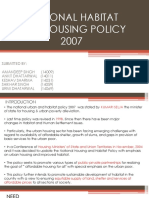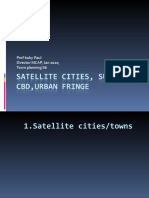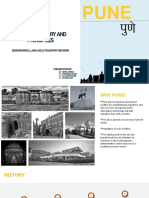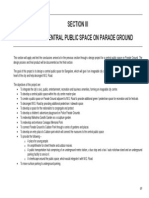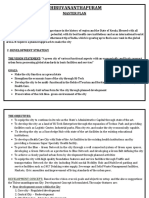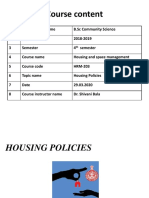National Urban Housing and Habitat Policy
National Urban Housing and Habitat Policy
Uploaded by
vvn123963Copyright:
Available Formats
National Urban Housing and Habitat Policy
National Urban Housing and Habitat Policy
Uploaded by
vvn123963Original Description:
Copyright
Available Formats
Share this document
Did you find this document useful?
Is this content inappropriate?
Copyright:
Available Formats
National Urban Housing and Habitat Policy
National Urban Housing and Habitat Policy
Uploaded by
vvn123963Copyright:
Available Formats
NATIONAL URBAN HOUSING AND HABITAT
POLICY - INDIA
National Urban Housing &
Habitat
Policy
2007 seeks to
promote various types of public-private partnerships for realizing the goal of
Affordable Housing For All with special emphasis on the urban poor.
The new Policy has been formulated keeping in view the changing socioeconomic parameters of the urban area and growing requirement of shelter
and related infrastructure .
This Policy intends to promote sustainable development of habitat in
the country with a view to ensuring equitable supply of land, shelter and
services at affordable
prices
to
all sections
of
society.
Given the magnitude of the housing shortage and budgetary constraints of
both the Central and State Governments, the National Urban Housing and
Habitat Policy, 2007 focuses the spotlight on multiple stake-holders
namely, the Private Sector, the Cooperative Sector, the Industrial Sector for
labour housing and the Services/ Institutional Sector for employee housing.
In this manner, the Policy will seek to promote various types of publicprivate partnerships for realizing the goal of "Affordable Housing for All".
The formulation of the National Housing Policy is an ongoing process
which started in 1986. Last time policy was revised in 1998. Since then
there have been major changes in Habitat and Human Settlement
issues. Particularly, the urban housing sector has been facing emerging
challenges with regard to availability of affordable shelter, growth of slums,
and gaps in provision of basic services to the urban poor. The urban housing
shortage has been estimated at about 24.7 million units at the end of the
10th Five Year Plan (2006-07). 99% of the shortage pertains to Economically
Weaker Sections (EWS) and Low Income Groups (LIG) categories. All these
aspects were considered in a Conference of Housing Ministers' of State
and Union Territories in November, 2004 and it was decided to update the
National Housing and Habitat Policy with emphasis on urban housing and
improved habitat. A Task Force was constituted in January, 2005 and a
National Urban Housing and Habitat Policy was drafted. This was circulated
amongst various stake holders. Based on wide ranging inputs received, the
National Urban Housing and Habitat Policy, 2007 has been finalised and laid
in the Parliament.
The salient features of the National Urban Housing &
Habitat Policy, 2007 :
Focus of the Policy is on affordable urban housing with special
emphasis on the urban poor.
Role of Housing and provision of basic services to the urban poor has
been integrated into the objectives of the Jawaharlal Nehru Urban Renewal
Mission (JNNURM).
Special emphasis has been laid on Scheduled Castes / Tribes /
Backward Classes / Minorities, empowerment of Women within the ambit of
the urban poor.
The Policy focuses on a symbiotic development of rural and urban
areas in line with the objectives of the 74th Constitution Amendment Act.
Within
the
overarching
goal
of "Affordable
Housing
for
All," emphasis has been laid on urban planning, increase supply of land,
use of spatial incentives like additional Floor Area Ratio (FAR), Transferable
Development
Rights,
etc.,
increased
flow
of
funds,
healthy
environment, effective solid waste management and use of renewal
sources of energy.
Encouraging Integrated townships and Special Economic Zones.
10-15% of land in every new public/private housing projects or or 2025% FAR whichever is greater to be reserved for EWS/LIG Housing through
appropriate spatial incentives.
Private Sector to be permitted land assembly within the purview of
Master Plans. Action Plans for urban slum dwellers and special package for
cooperative housing, labour housing and employees housing is to be
prepared.
States to be advised to develop 10 years perspective plan for housing
of EWS/LIG.
Policy gives primacy to provision of shelter to urban poor at their
present location or near their work place.
Approach will be in-situ slum rehabilitation. Relocation will be
considered only in specific cases.
Micro finance institutions to be promoted at state level to expedite flow
of finances to urban poor.
Model municipal laws to be prepared by the Central Government.
Detailed city maps to be prepared based on GIS, aerial survey and
ground verification.
Use of proven cost effective technology and building materials to be
encouraged.
Development of mass rapid transit system at sub-regional level
envisaged.
Green cover for cities to be encouraged for balanced ecological
development.
All States to be encouraged to develop a "Habitat Infrastructure Action
Plan" for all cities with a population of over one lakh.
The Action Plan stated in the Policy is as follows:
Encouragement
and
support
to
be
provided
to
State
Governments by the Central Government for preparation of State
Urban Housing and Habitat Policy and Action Plan.
State/UT Action plans to focus on accelerated flow of funds.
State / UT level policy to provide road map for institutional, legal
and financial incentives.
State / UT plans to indicate concrete steps for encouraging a
participatory approach.
Periodic review of implementation of Policy and Action Plan at
State level to be carried out.
Preparation of 15-20 years perspective plans in the form of City
Development Plans (CDPs) based on spatial planning at the city level.
Setting up of a High Level Monitoring Committee for periodic
review and implementation of the Policy and for making amendments,
modifications wherever considered necessary.
Sustainability Concerns
i) Green belts will be developed around cities with a view to maintaining the
ecological balance.
ii) Suitable green recreational areas like zoo, lakes and gardens will be
earmarked /developed for public visits in the Master Plan of each city/town.
iii) Water bodies will be protected with special emphasis on keeping the flood
plains of tropical rivers free from construction or encroachments.
iv) Efforts will be made to protect large depressions from being filled up since
they are natural drainage points for conservation of water and can be
developed as suitable water bodies.
v) Efforts will be made to encourage cities/towns to keep a significant
proportion of the total Master Plan area as green lungs of the city.
vi) Efforts will be made to encourage States/UTs to develop Sub-regional /
Special Area Development Plans for areas with fragile ecological
characteristics on the basis of Environment Impact Assessment (EIA) so as to
take care of all environmental concerns at the planning stage itself in
consultation with the Ministry of Environment & Forests.
vii) Growth of a city beyond reasonable limits imposes unbearable strain on
its services. City planners would be encouraged to lay down norms for
development of urban sprawls and satellite townships.
viii) Reduction in the rate of in-migration into mega and metro cities is
urgently needed through preparation of State/UT level regional Plans based
on fast transport corridors for balanced growth.
ix) Model bye-laws will be developed to promote the use of renewable energy
sources particularly solar water heating systems in residential and
commercial buildings.
x) Poverty and unemployment are detrimental to the well balanced growth of
urban settlements. States/UTs Governments and local authorities will be
encouraged to formulate and implement poverty alleviation and employment
generation programmes based on skills training especially in the services
sector
You might also like
- Housing Affordability Impacts of Homeaway in SeattleDocument21 pagesHousing Affordability Impacts of Homeaway in SeattleTodd BishopNo ratings yet
- Improving Interchanges: Toward Better Multimodal Railway Hubs in the People's Republic of ChinaFrom EverandImproving Interchanges: Toward Better Multimodal Railway Hubs in the People's Republic of ChinaNo ratings yet
- Capital PPT - LVLDocument18 pagesCapital PPT - LVLSushmita Mulekar100% (2)
- MANDAI A4Document27 pagesMANDAI A4Abhishek Singh50% (2)
- Brick Township Master PlanDocument192 pagesBrick Township Master PlanTownshipofBrickNJ50% (2)
- Housing National Habitat Policy 2007Document24 pagesHousing National Habitat Policy 2007YuvanshGoelNo ratings yet
- UNIT 1 Urban Housing PDFDocument68 pagesUNIT 1 Urban Housing PDFAnirudh VijayanNo ratings yet
- Jaipur Development Plan Existing Profile Jaipur Region Vol 1Document315 pagesJaipur Development Plan Existing Profile Jaipur Region Vol 1Abhishëk ChhonkarNo ratings yet
- Gujarat Case StudyDocument4 pagesGujarat Case Studysketch up0% (1)
- Basic Services To Urban Poor (BSUP)Document17 pagesBasic Services To Urban Poor (BSUP)Neha KumawatNo ratings yet
- UNIT-2 Notes B.Arch HousingDocument104 pagesUNIT-2 Notes B.Arch HousingHasiba Barisa50% (2)
- Charkop Sector 1 Sites & Services SchemeDocument31 pagesCharkop Sector 1 Sites & Services SchemeDhruv KarpeNo ratings yet
- Raj Rewal FinalDocument32 pagesRaj Rewal FinalAnkur GuptaNo ratings yet
- Satellite TownsDocument81 pagesSatellite Townsakhil rajNo ratings yet
- Gandhinagar - Town Planning: Name - Pragathi S USN - 1MS16AT043 Class - 7TDocument6 pagesGandhinagar - Town Planning: Name - Pragathi S USN - 1MS16AT043 Class - 7TFashionable JewelleryNo ratings yet
- Gandhinagar: By: Tanaya R. Shivani T. Priyal S. Shivani K. Aman B. PrathameshDocument12 pagesGandhinagar: By: Tanaya R. Shivani T. Priyal S. Shivani K. Aman B. PrathameshGeeta J. SavlaNo ratings yet
- Case Study of Delhi: Urban DesignDocument38 pagesCase Study of Delhi: Urban DesignMukul Pratap singhNo ratings yet
- Landuse Transformation - Walled City, JodhpurDocument66 pagesLanduse Transformation - Walled City, JodhpurKirti Kalla100% (3)
- Rajiv Awas Yojana GuidelinesDocument24 pagesRajiv Awas Yojana GuidelinesSherine David SANo ratings yet
- Ahmedabad CityDocument7 pagesAhmedabad CityakankshapenNo ratings yet
- PUNE-Planning PrinciplesDocument24 pagesPUNE-Planning Principles7007Neeraj BhirudNo ratings yet
- Rajiv Awas YojanaDocument23 pagesRajiv Awas YojanaRitika KherotiaNo ratings yet
- National Rural Housing and Habitat PolicyDocument15 pagesNational Rural Housing and Habitat PolicyBasim Ahmed100% (1)
- Proposed SSMDocument24 pagesProposed SSMfrequentlyNo ratings yet
- Neighborhood Design - CEPT Portfolio PDFDocument12 pagesNeighborhood Design - CEPT Portfolio PDFAaditya AgarwalNo ratings yet
- Housing Case StudyDocument7 pagesHousing Case StudyTwinkleNo ratings yet
- High Rise BuildingDocument21 pagesHigh Rise BuildingPavithra.GNo ratings yet
- Historical Transformations in Boundary & Land Use in Rural' DelhiDocument1 pageHistorical Transformations in Boundary & Land Use in Rural' Delhisuhani100% (1)
- Case Study, Indore Slum CityDocument22 pagesCase Study, Indore Slum Cityshikha50% (4)
- Public Open Space in BangaloreDocument53 pagesPublic Open Space in BangaloreSindhu BairaviNo ratings yet
- Case Study Palava Housing by Rohit PatelDocument2 pagesCase Study Palava Housing by Rohit PatelRohit Arya Patel50% (2)
- Housing Policies in Five Year Plans of IndiaDocument20 pagesHousing Policies in Five Year Plans of IndiaLavanya Jothi Venkatachalam50% (2)
- Unit 03Document27 pagesUnit 03Ashafali KNo ratings yet
- Housing For Urban Poor: Scenario and Solutions For IndiaDocument25 pagesHousing For Urban Poor: Scenario and Solutions For IndiaShubhamNo ratings yet
- Pari Chowk Greater Noida ProjectDocument59 pagesPari Chowk Greater Noida ProjectRishabh anandNo ratings yet
- Indirapuram Case StudyDocument11 pagesIndirapuram Case StudyShefali GoswamiNo ratings yet
- Town Centre AmanoraDocument11 pagesTown Centre AmanoraRutu LotiaNo ratings yet
- Raj Rewal Asia Games Housing PDFDocument8 pagesRaj Rewal Asia Games Housing PDFClara Viegas100% (4)
- WTP - Case StudyDocument19 pagesWTP - Case Studyamogh renuseNo ratings yet
- Transit Oriented Development TOD NAYA RAIPUR NEW DELHI CASE STUDYDocument45 pagesTransit Oriented Development TOD NAYA RAIPUR NEW DELHI CASE STUDYsheenam100% (1)
- Affordable HousingDocument9 pagesAffordable HousingRekha prajapatiNo ratings yet
- PlanningDocument3 pagesPlanningNazeeha NazneenNo ratings yet
- Patrick GeddesDocument10 pagesPatrick GeddesmehalshahNo ratings yet
- KhyahDocument74 pagesKhyahShashi Kant SinghNo ratings yet
- Asiam Games VillageDocument18 pagesAsiam Games Villageriddhi patel100% (1)
- Elements of Urban Planning: CommucationsDocument5 pagesElements of Urban Planning: CommucationsSamy DagneNo ratings yet
- Princess ParkDocument22 pagesPrincess ParkpuneetNo ratings yet
- HSP - Integrated TownshipDocument56 pagesHSP - Integrated TownshipSAKTHI MANNARMANNANNo ratings yet
- 31.08.2020 - Khan Market Site DocumentationDocument49 pages31.08.2020 - Khan Market Site DocumentationVanshika DograNo ratings yet
- Thiruvananthapuram: Master PlanDocument10 pagesThiruvananthapuram: Master PlanJaisurya SharmaNo ratings yet
- Case Study Sec-17Document9 pagesCase Study Sec-17anusha8204No ratings yet
- List of Figure: Integrated Townships: Magarpatta CityDocument12 pagesList of Figure: Integrated Townships: Magarpatta CityZINAL PATELNo ratings yet
- Housing in Five Year PlansDocument20 pagesHousing in Five Year PlansLavanya Jothi Venkatachalam100% (2)
- Slum RedevelopmentDocument16 pagesSlum RedevelopmentchetnaNo ratings yet
- Thesis Case StudyDocument13 pagesThesis Case StudyYOGITA VAGHMARENo ratings yet
- SlumsDocument36 pagesSlumsDevyani Totla0% (1)
- 2.panchkula - Live Case Study 1Document4 pages2.panchkula - Live Case Study 1Tarun KumarNo ratings yet
- National Urban Housing & Habitat Policy (NUHHP), 2007Document13 pagesNational Urban Housing & Habitat Policy (NUHHP), 2007Mohd Rehan50% (2)
- Focus Area Aims of NUHHP 2007Document5 pagesFocus Area Aims of NUHHP 2007rajanNo ratings yet
- National Urban Housing and Habitat Policy 2007: I. The Need For PolicyDocument10 pagesNational Urban Housing and Habitat Policy 2007: I. The Need For PolicyJaanissar GeraNo ratings yet
- Housing Issues-Indian Context: 1.3 Salient Features of National Urban Housing & Habitat PolicyDocument21 pagesHousing Issues-Indian Context: 1.3 Salient Features of National Urban Housing & Habitat PolicyPreethiNo ratings yet
- Housing PoliciesDocument38 pagesHousing PoliciesShreyali Agarwal100% (1)
- The Main Challenges Faced by Cities To Provide Adequate and Affordable Housing For All InhabitantsDocument3 pagesThe Main Challenges Faced by Cities To Provide Adequate and Affordable Housing For All Inhabitantsyddmd5jnw5No ratings yet
- Cost - Effective HousingDocument17 pagesCost - Effective HousingpriyankaNo ratings yet
- 2021 Report On HomelessnessDocument46 pages2021 Report On HomelessnessGenna ContinoNo ratings yet
- Thesesaastu-2019-291 2 PDFDocument89 pagesThesesaastu-2019-291 2 PDFKAAYA FILMSNo ratings yet
- Low-Cost Housing in IndiaDocument8 pagesLow-Cost Housing in IndiaMuhsin MuhammadNo ratings yet
- Literature Review On Housing Finance in IndiaDocument8 pagesLiterature Review On Housing Finance in Indiaafmzubsbdcfffg100% (1)
- Analysis of Nigeria's Housing PoliciesDocument10 pagesAnalysis of Nigeria's Housing PoliciesSiji OladejiNo ratings yet
- DeKalb FreePress: 01-10-20Document12 pagesDeKalb FreePress: 01-10-20Donna S. SeayNo ratings yet
- BSE Company Research Report - Saurashtra Cement LTDDocument5 pagesBSE Company Research Report - Saurashtra Cement LTDdidwaniasNo ratings yet
- RE: Memorandum of Opposition To S.5768 (Martins) and A.7944 (Wright) - Prevailing Wage Mandate On Private Affordable HousingDocument3 pagesRE: Memorandum of Opposition To S.5768 (Martins) and A.7944 (Wright) - Prevailing Wage Mandate On Private Affordable HousingNick ReismanNo ratings yet
- Aftab Pureval's Affordable Housing PlanDocument14 pagesAftab Pureval's Affordable Housing PlanWVXU NewsNo ratings yet
- Dubai VS Pakistan Real Estate MarketDocument21 pagesDubai VS Pakistan Real Estate Marketmaleeha shahzadNo ratings yet
- The State of Lagos Housing Market Report TEASER N75000 PERDocument21 pagesThe State of Lagos Housing Market Report TEASER N75000 PEROkewole Olayemi SamuelNo ratings yet
- Research Paper Low Cost HousingDocument4 pagesResearch Paper Low Cost Housingkarthik subramaniamNo ratings yet
- Pangasinan State University: Housing and Human SettlementsDocument21 pagesPangasinan State University: Housing and Human SettlementsMarinelle MejiaNo ratings yet
- HARBOR BRIDGE REPLACEMENT PROJECT: Four Party AgreementDocument48 pagesHARBOR BRIDGE REPLACEMENT PROJECT: Four Party AgreementcallertimesNo ratings yet
- Barangay Labangon Shelter Plan: Group 6 Blackjacks Ar 3134 HousingDocument21 pagesBarangay Labangon Shelter Plan: Group 6 Blackjacks Ar 3134 HousingGicelle SenoNo ratings yet
- UTTIPEC - Transit Oriented DevelopmentDocument24 pagesUTTIPEC - Transit Oriented DevelopmentSayali Lokare100% (1)
- 2018 Housing Is Fundamental Report by United Way of Peterborough and DistrictDocument8 pages2018 Housing Is Fundamental Report by United Way of Peterborough and DistrictPeterborough ExaminerNo ratings yet
- Safer and Affordable Housing For Urban PDocument71 pagesSafer and Affordable Housing For Urban PPATRICE NICOLE TRINIDADNo ratings yet
- Presentation Materials 2 PDFDocument21 pagesPresentation Materials 2 PDFMr PolashNo ratings yet
- 2018 Adopted TIF PoliciesDocument9 pages2018 Adopted TIF PoliciesSean BakerNo ratings yet
- HDB Punggol 5room Sep DecDocument14 pagesHDB Punggol 5room Sep DecNominee OnlineNo ratings yet
- BMP Software Developer Business Plan 1Document43 pagesBMP Software Developer Business Plan 1msamala09100% (1)
- Affordable Housing in India : Ms. Harshleen Kaur SethiDocument8 pagesAffordable Housing in India : Ms. Harshleen Kaur SethiNipra GuptaNo ratings yet
- The Inevitable Change of Bushwick: A Neighborhood in Between The Global City and The SuburbsDocument47 pagesThe Inevitable Change of Bushwick: A Neighborhood in Between The Global City and The SuburbsUrbanisms of InclusionNo ratings yet
- Hypostat 2018 Final PDFDocument148 pagesHypostat 2018 Final PDFLucian NechitaNo ratings yet
- Urban Planning in Developed CountriesDocument58 pagesUrban Planning in Developed CountriesLorena CastañedaNo ratings yet





